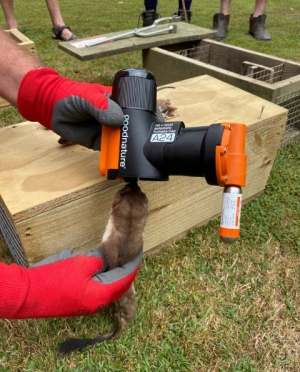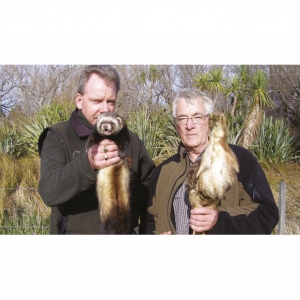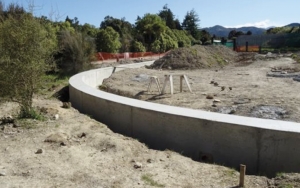Displaying items by tag: Trapping
Gone fishin' and trapping
The number of whio in the Tongariro catchment is growing, thanks to a recovery plan run by the Department
of Conservation from 2009 to 2019 and groups of volunteers who monitor hundreds of traps in the region.
Two Taupō Fishing Club members and dedicated trappers Chris Pritt – the sister of DU Patron Di Pritt – and Lesley Hosking are been doing their bit on the upper reaches of the Hinemaiaia River. Lesley says, "We have trapped mostly rats and other predators on the upper Hinemaiaia River for more than two years, starting in August 2018 with only eight trap stations. We now check 42 traps every week – these are 36 box traps with DOC 200 trap mechanisms and 8 Goodnature A12 or A24 gas operated traps.
"We took over this part of the river to assist and free up David Cade (aka Didymo Dave) who started the trapping with the aim of getting the native birdlife to flourish again. He now traps further upstream on a regular basis while we patrol the well-worn fishing tracks and three car parks."
Didymo Dave has been trapping on the Hinemaiaia for 10 years and in 2019 caught his 1000th rat. "To date we have trapped 328 predators which include hundreds of rats and mice, four weasels, two stoats, and one possum, which was in the DOC 200 trap," Lesley says.
Pic's Peanut Butter is their bait of choice and they use about 5kg every six weeks. The peanut butter is waste from the Pic's factory which sells it at a reduced price on the Predator Free website. It is not edible as it has a greenish additive.
"By trapping so rigorously, we now have the reward of seeing North Island robin, tomtits, kereru, fantails, tui, bellbirds, whiteheads, and two whio have moved in near Car Park 3; we hope they will mate and there will be more whio. The pair seem overly friendly and we think perhaps they have originated from the Tūrangi whio raising enclosure," Lesley says.
Lesley and Chris are unsure if the whio nested this season but say they have taken up residence on the far side of the river where there are no fishing tracks.
The Taupō Fishing Club originally became involved in vermin trapping because its members were sick of rats chewing newly caught trout laid out on the riverbank while they continued fishing.
The two women fish two or three days a week on Flaxy Lakes, the Tongariro River and river delta, Waimarino River mouth, and in summer, they boat fish on Lake Taupō.
In January, their volunteer work was nationally recognised by the New Zealand Sports Fishing Council which awarded Lesley and Chris its 2020 Volunteers of the Year award.
As well as their trapping work, the pair worked together to save the Taupō Fishing Club when it was facing physical, financial and administrative collapse.
Club president Shirley Fraser says, “Our clubrooms were in desperate need of maintenance after having been neglected for years. Extensive rat damage had resulted in major water damage."
The building was collapsing and needed repainting, the roof needed repairing and guttering, wiring, and plumbing needed replacing.
“Not only did they do much of the prep work, painting, cleaning and so on, they organised quotes, oversaw the tradesmen and brought the project in under budget. Now the rooms are a pleasure to call ours.”
Lesley and Chris also took on the job of implementing a new administration system and overhauling the club finances and reporting systems.
Let’s hit them with some tech
DU Director Dan Steele looks at another tool to help in the fight against predators.
The biggest problem with conservation in New Zealand is complacency and believing that someone else is looking after mother nature on your behalf.
So many people leave things to the Department of Conservation and believe that that’s enough.
It’s not, it’s going to take a huge combined effort from many New Zealanders and particularly landowners to slow the decline in our biodiversity caused by these introduced pests.
But it is not easy to start a conservation project, it is usually an extra job for already busy landowners and who pays, how is it going to be maintained and what should be done?
We ran a really good trapping demonstration for our local sustainable farming group last week, the Taumarunui Sustainable Land Management Group.
Mustelid expert Professor Carolyn (Kim) King, of Waikato University, gave a great overview of New Zealand pests, how we got to this point and whether pest-free New Zealand has any hope of success. The jury is still out on this.
But she believes future technology may well make it possible.
We’re trying to demonstrate that it’s quick and easy to set a few traps around the farm; knowing what to do is often the biggest obstacle with farmers. Then of course there is the capital cost to set up traps and the ongoing maintenance. Goodnature, a Wellington pest company founded 13 years ago, is certainly making the setup and the maintenance easy with their well thought-out technology.
The new Chirp feature on their traps provides bluetooth information from the trap direct to your smartphone.
You link your phone to the trap and it logs the GPS coordinates, and when you check the trap, it tells you how many strikes the trap has had and when.
Then once you’re back into cellphone reception or internet connection, the information is automatically uploaded to the cloud onto the Goodnature world map.
Your traps and kills can be viewed by anyone looking at the map – they show up orange.
Cunningly though, when people are viewing your traplines, they can only see to within 150 metres of where you have your traps placed, so people can’t turn up and steal or sabotage your traps. The owner of the traps can however have their GPS coordinates down to a metre or two.
We are finding the A24 Goodnature traps a good way for people to sponsor some traps, to be involved and stay in touch with how the conservation work
is performing.
It’s so important to be holding our ground against predators; this week at Blue Duck Station, we have had a kaka sighting and a report of a bittern booming.
The Goodnature A24 rat and stoat trap automatically kills 24 rats or stoats (and mice) one after the other, before you need to replace the CO2 gas canister. When the pest tries to reach the lure inside the trap, they brush past a trigger which fires a piston, killing them instantly. The piston retracts and resets ready for the next pest. The trap comes with a pump that refreshes the lure automatically for six months. Three different trap kits are available: a trap-only kit, a trap with a counter or a trap with Chirp.
Pest problem – A24 helps
Blue Duck Station, where DU director Dan Steele and his family live, work, conserve and save ducks, have discovered traps that seem to be super efficient. Here is something about them.
We are pretty excited about the latest technology for dealing with pests; Good Nature’s A24. The A24 is quite different from the DOC200 (350 of which we maintain), and has some advantages over it. The A24 does not need regular maintenance as it automatically re-sets and is therefore great for places with difficult access. The auto- resetting also means they have the potential to catch more as there is no waiting period between kills.
For these reasons we plan to put them in the far back blocks and inaccessible ridges on the station. We have also purchased some counters to indicate when to replace the gas canisters and to give us some catch numbers.
The A24 cannot tell you what it has caught as the carcasses of the creatures rot away or are often carried off by other predators so we will continue to rely on our DoC200s for this. We plan to record A24 catch numbers however and add them to our catch database, linked to our GoogleEarth application.
We believe that anything is worth giving a go in our battle against predators and protecting our whio and other species. We do not plan to replace our DoC200s with A24s but will use them as an addition and in different areas. We are looking forward to seeing results after we have had the traps up for a while.
It is also worth mentioning that the public feel the same, as two of our A24s have been sponsored by visitors as part of our ‘sponsor a trap’ programme!
*Blue Duck Station hosts a number of overseas people they call eco warriors, who visit and work on the station, learning about conservation and helping to protect the Whio.
The traps Department of Conservation uses
Animal pests and predators are a major threat to the survival of New Zealand’s special native flora and fauna.
A wide range of techniques and tools are used to control pests, depending on the threats and the terrain. Ground control is Department of Conservation’s main approach. They use traps, bait stations or culling. It can prove highly effective where the terrain is suitable and regular checks can be made.
It is DoC’s most widely used pest control approach with more than 400,000 hectares under ground control management. Around 80 percent of the Animal Health Board’s operations are ground control. Ground control methods are precise, but are also labour- intensive and expensive.
This website will inform you of three new types of humane kill traps developed by the Department of Conservation and Philip Waddington. These traps are designed to assist conservationists with their protection of native species that have almost been wiped out by introduced predators.
These traps are regarded as innovative and responsible:
The DOC 150 and 200 humanely kill three pest predators - stoats, rats and hedgehogs.
The DOC 250 targets and humanely kills four pest predators - ferrets, stoats, rats and hedgehogs.
Pests best dead
Trapping is the name of the game.
DU member of Pohangina wetlands Gordon Pilone, sent in these shots of a recent catch.
He uses DOC 250 traps to eliminate stoats, rats and hedge hogs.
The kill traps are elevated on a plank on blocks to delay weed invasion and stoats seem to like “running the plank”.
Gordon said a hen egg as bait can be successful even at several weeks old. Also used successfully for stoat kill, is a Timms tunnel trap baited with a fish head.
Predating the predators
To help protect the birds, a trapping programme is underway to get rid of ferrets and other pests to provide a safer environment for rare native birds in the Wairarapa Moana wetlands.
These include Australasian bittern, royal spoonbill and the dabchick. Greater Wellington Regional Council (GWRC) started trapping around Matthews lagoon and Boggy Pond in July. Using covered traps that exclude birds, pest animal officer Steve Playle was successful straight away, catching 13 ferrets and three feral cats in the first month.
“These are large and powerful predators that need to catch and kill regularly. If we can control them around the wetlands, the wetland birds are bound to increase in numbers,” he said.
Hawke’s Bay wetland bird expert and Ducks Unlimited president John Cheyne, said numbers of Australasian bittern were low in a count taken earlier this year, and the work being done by officers like Steve should help raise bird numbers in the wetlands.
“There is a lot of great wetland habitat at Wairarapa Moana, but I only heard eight bitterns calling. There should be more.
Trapping ferrets and feral cats should allow them and all the other ground-nesting birds to breed more successfully.” The trapping programme is part of a wider project to enhance the wetlands around Wairarapa Moana, involving the councils, DoC, iwi, farmers, environmental groups and the community.
Story courtesy of the Greater Wellington Regional Council.
Kahikatea wetland at Motu
Motu Scenic Reserve is a 20 hectare kahikatea wetland forest located just past Motu township in the Eastern Bay of Plenty.
The reserve is unique as it contains: an oxbow wetland (crescent-shaped lake lying alongside a winding river) and an original kahikatea swamp forest, one of only two percent left in New Zealand.
The remainder of the reserve is alluvial forest with a low canopy of houhere (lacebark) and wheki-ponga (tree fern). Kahikatea (white pine) emerge 30 metres above the canopy. Motu Scenic Reserve is also habitat for aquatic bird species and provides valuable habitat for weka and common bush birds. Visitors can access the reserve, although there are no formal walking tracks.
In 1913 the government approved 70 acres of native bush and lagoon for Motu Scenic Reserve now managed by the Department of Conservation. Visitors from the Motu Hotel often went boating on the lake in the early 1900s when the hotel was at its most popular.
A photo taken by well known local photographer William Crawford in the 1900s features the oxbow lake with Christian Hansen rowing his children and James Whinray (nearby Whinray Scenic Reserve is named after).
DoC undertakes trapping, weed control and restoration planting at the reserve.
The trapping programme targets rats, mustelids and possums. While weed control focuses on Japanese honeysuckle, old man’s beard, English ivy, Japanese walnut and various willow species. Visitors can learn more about problem weeds in the reserve from an information panel installed next to the lake.
Sponsorship from Matua Wines has enabled restoration planting of manuka, flax, karamu, kahikatea and koromiko on the grassy margins of the reserve.
Motu Scenic Reserve is 47km from Opotiki, and 87km from Gisborne, turn off at Matawai on the Motu Road. At the township keep left, cross the bridge over the Motu River and the entrance to the reserve is located on the corner of Motu Road and Phillips Road. Nearby places are the Whinray Scenic Reserve Track and Pakihi Track.
For more information check out doc.govt.nz
Trapline volunteers
The old traps came out of the boxes and new stainless steel ones went in. Replacing a line like this can take a couple of weeks so the volunteers really made a difference. With each person carrying six traps in and another six out as well as some tough climbs along the way, it was a big day.
This trap line protects the whio living along streams and rivers such as the Maketawa and they form a network that covers around 7000 hectares. Last year was a record year for whio ducklings in the Park with 33 ducklings hatching in the wild.
Recently though he’s found another.”
Whitefaced herons are New Zealand’s most common heron. They arrived from Australia in the 1940s so they’re considered native. This one’s been around long enough to be called a local.
Trapping at Boggy/Wairio
Trapping at Boggy/Wairio in April by Steve Playle resulted in the following critters recorded - 4 cats, 1 ferret, 9 rats, 3 mice, 1 magpie and 17 hedgehogs.
The grand total came to 15 cats, 36 ferrets, 1 stoat, 9 weasels, 130 hedgehogs, 46 rats, 21 mice, 3 magpies, 1 harrier hawk and 1 rabbit.
Steve also saw a Bittern in Boggy Pond down where the culvert pipes are beside the Boggy stop bank. That photo is on the front cover.
Steve has since put in other trap sites along the new track to the viewing hide out by the spillway.
Pukaha Mt Bruce ups the anti on Predators
New self re-setting traps for Pukaha
Pukaha has been looking at a wider range of options for predator control in the reserve and the surrounding buffer zone. Then thanks to a generous donation from Pub Charity, they were able to purchase a number of A24 self resetting stoat and rat traps.
You can check them out at www.goodnature.co.nz
The initial consignment of traps are for their buffer zone provided by the Greater Wellington Regional Council and are also near the aviaries at the Visitor Centre. This February they will be rolling out these devices into their ‘front face’ to supplement the current DoC 250 traps.
The total number of rats caught in the 12 month period September 2014 - September 2015 in both the reserve and buffer zone was 1530. The number of mustelids (weasels, stoats and ferrets) was 104.
Pukaha are continuing to look at innovative predator control techniques and will keep supporters updated on progress.
Picture:
Concrete, concrete and more concrete was the order of the day when the footing was laid for the new free flight aviary. The construction was underway thanks to the teams at Rigg-Zschokke Ltd and Higgins Contractors, The team at Puckaha Mt Bruce were hoping that all going to plan they are aiming for an opening date in late February 2016.






